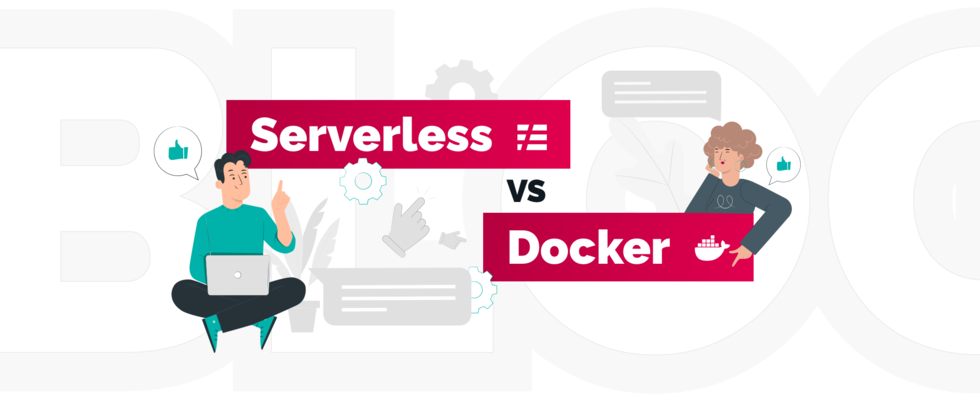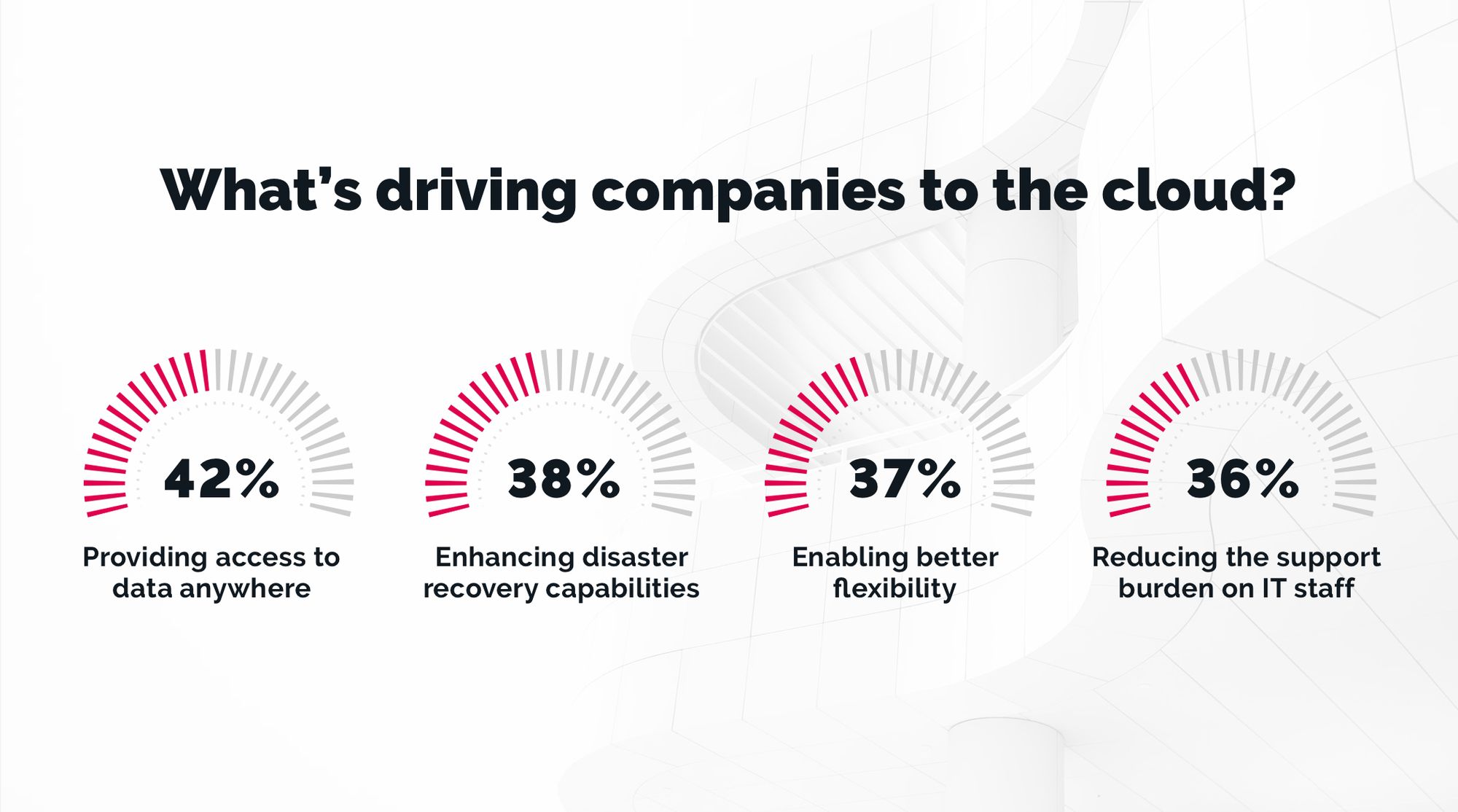Serverless vs Docker Containers: What to Choose?

Content Marketing Manager at TechMagic. Mainly focused on content marketing, SEO optimization, and media relations.

Get key insights into cloud computing tech and discover Serverless vs Docker Сontainers similarities and differences in 2023. Read now!
Let’s start with the fact that cloud computing is growing exponentially. Businesses are continually migrating from traditional data centers and inefficient physical servers to innovative cloud technologies and microservices architectures. What are the key factors driving businesses to build or migrate their architectures to the cloud? Based on a recent survey we highlighted the main benefits of cloud computing that are vital for most businesses.
Today there is an increasing number of different cloud services that enable developing more cost-efficient applications with higher performance and more effortless scalability such as Infrastructure as a Service (IaaS), Platform as a Service (PaaS), Function as a Service (FaaS), and Software as a Service (SaaS). If you’ve been looking for a full-service framework solution for your business needs, then it’s likely that you’ve come across the concepts of Serverless and Docker, that represent FaaS and PaaS models, respectively. Many experts now consider these solutions as the best practices in cloud computing as they offer simplicity and flexibility in application development and deployment. However, they have some unique differences that we are going to cover today.

Serverless vs. Docker Containers
To start, it's worth saying that both Serverless and Docker point out an architecture that is designed for future changes and for leveraging the latest tech innovations in cloud computing. While many people often talk about Serverless computing vs. Docker containers, the two have very little in common. That is because both technologies aren’t the same thing and serve a different purpose. First, let’s go over some common points:
- Minimum overhead
- High performance
- Requires minimal infrastructure provisioning
Although Serverless is more innovative technology than Docker, they both have their disadvantages and benefits that make them both useful and relevant. So let's review the two.
Interested to learn more about TechMagic?
Contact usHow Does Serverless Work?
Serverless computing is a striking trend in the cloud landscape. The main essence is that you do not need to provide equipment, network nodes, and storage. Instead, you just write your code, pack it (often in a container) and call it whenever you want. In serverless, developers can purchase backend services from a vendor depending on their current needs. The charge could be less as developers only pay for the features needed. Developers write the functions that they need for an application. This is executed by a vendor. Once the function is running in an application, it is sent to the client.
The architecture also allows you to add new functionality to the system much faster. So serverless reduces development time and lets programmers focus solely on the application’s business logic and coding. As a result, the time to market for development is reduced. As a bonus, you can get automatic scaling to the load, and pay only for the resources used and only at the time when they are used. There are so many serverless benefits for startups that help them to go to market faster and easier.
Advantages of Serverless
No Servers
When serverless is used, developers do not have to deal with servers. Even though servers are used, it is solely the responsibility of the vendor. A major advantage of having no operating system is an opportunity to greatly reduce costs. Additionally, serverless gives developers the possibility to expand applications despite the capacity of a vendor's server. This is one thing to consider when looking at serverless vs containers.
Efficient Scalability
A major benefit of serverless is scalability. An application built on a server can fail to function whenever there is a sudden increase in usage. Serverless allows automatic scaling of applications. If the usage increases, applications built with serverless technology can meet up to the demands. A vendor can increase the speed of servers to meet new demands. At the end of the day, a serverless application can handle an unlimited number of requests. Developers can choose the desired capacity of applications as needs change.
Cost-effective
In serverless computing and when comparing Docker vs serverless functions, developers only pay for the functionalities used. Using exact services means that charges can be reduced to the minimum. If additional functionality is required, a developer can purchase that capacity. This is in contrast to a traditional architecture, which requires developers to know how much functionality they would need before commencing a project. Serverless computing code will only run when backend functions are needed with AWS consulting serviсes.
Faster Deployment
Serverless allows developers to release applications faster because of the ability to add bits of code at a time. There is no need to upload codes to servers before an application is launched. This makes the process faster. Applications built on serverless computing do not have a monolithic architecture. This means that developers can either upload the entire code or add single capabilities as needed. With this system, running updates or making changes becomes easier.
Decreased Latency
When containers vs serverless are compared, serverless provides decreased latency and start-up time. Code can run from anywhere because applications are not run on a server. So developers can use servers that are close to users. Because requests no longer need to travel to a server far away, it greatly reduces latency.
Easier updating process
Updating or modifying a single function is typically easier to do in a Serverless architecture.
Event triggers
Almost all Serverless solutions support event triggers, which means they are great for pipelines and sequenced workflows.
Disadvantages of Serverless
- Serverless is considered a “black box” technology, which means you don’t necessarily know what’s going on inside.
- As a Serverless application grows, the complexity of troubleshooting explodes because of the way FaaS applications are designed to work.
- Serverless always depends on a third party vendor, so changing the cloud provider can be a headache.
- Depending on the workload, Serverless architectures can take a lot of the expensive overheads in terms of operating and supporting the basic infrastructure.
- Serverless architecture sometimes can be very tricky to get right and typically requires significant upfront human resource costs.
- The four major services that are being utilized for Serverless orchestration are Amazon Step Functions, Azure Durable Functions, Google Cloud Dataflow, and IBM Composer.
Examples
Here are a few companies and startups that use Serverless right now: Netflix, Codepen, PhotoVogue, Autodesk, SQQUID, Droplr, AbstractAI.
To get more information about Serverless, refer here:
- AWS Lambda - run code without thinking about servers. Pay only for the compute time you consume.
- Serverless computing - Focus only on building great applications
- Serverless Framework. The most widely-adopted toolkit for building serverless applications.
- Serverless computing. Take your mind off infrastructure and build apps faster
- IBM Cloud Functions. Execute code on demand in a highly scalable serverless environment
Interested to learn more about TechMagic?
Contact usHow Does Docker Work?
Today, we hear more about technologies as Docker vs containers like Kubernetes. Docker has become more popular at a container orchestration point. Docker cloud computing is also one of the leading tools used in the industry. Docker is designed to simplify the creation of apps. It was built as a virtual machine that allows the use of the Linux kernel. This applies to all types of operating systems. Docker reduces the size of an application while increasing its performance. It is an ideal tool that can benefit both developers and system administrators.
Advantages of Docker
Enhanced Productivity
When speaking of compute services, Docker stands out. Docker provides a standardized environment across several developmental cycles. With this standardized infrastructure, it is easier for engineers to identify and get rid of any security issues early on.
Docker provides different environments based on app requirements by using containers. So that it’s easy to transfer and run the application anywhere you want.
Scaling without limit
Container technology enables you to scale your applications as much as you want. Going Serverless, that’s not always the case, as sometimes it may cause size and memory restrictions.
Multi-Cloud Services
Major container cloud computing vendors throughout the world have recently adopted Docker. These vendors also added individual support systems to facilitate the use of Docker. Google Compute Platform is among some of the companies that have embraced this version of container computing. Docker is perfect for providers such as Azure, which can then be used with a configuration manager.
Security
Docker's security allows complete isolation of apps. Without this, it is impossible to have absolute control over traffic. This type of security system prevents Docker from looking inside other containers.
Continuous Deployment
When you compare, for example, other orchestration tools and containers vs Docker, the latter provides great flexibility. Docker computing technologies allow developers to easily make changes. It is also possible to test containers while implementing changes. Images can be built, tested, and deployed over multiple servers. The configuration and dependencies in Docker are maintained internally, which means less room for discrepancies.
Isolation of Resources
Isolation and segregation of your resources are possible with Docker. Each app allocates its own resources, which has a role in reducing costs. Specified apps will not utilize all the available resources and this usually leads to downtime for other apps.
Docker also allows various containers of separate applications to run entirely alternate stacks. Because each application runs on its own container library, clean app removal is ensured. Any obsolete or unnecessary application can easily be deleted without affecting other files.
Advantages for developers and sysadmins
Docker produces an API for container management in an image format and a chance to use a remote registry for sharing containers. This scheme serves both developers and system administrators with advantages, for instance.
Disadvantages of Docker
- Containers don't run at bare-metal speeds. Indeed, containers utilize resources more efficiently than virtual machines, but they are still subject to performance overhead due to overlay networking, interfacing between the container and the host system, and so on.
- By default, all of the data inside a container disappears forever when the container shuts down unless you save it somewhere else first. There are ways to save data persistently in Docker, such as Docker Data Volumes, but this is probably a challenge that still has yet to be addressed in a seamless way.
- Although the core Docker platform is open source, due to competition between the companies that back them, some container products don't work with other ones. For example, OpenShift only works with the Kubernetes orchestrator.
- Docker containers were designed as a solution for deploying server applications that don't require a graphical interface. While there are some creative strategies (such as X11 video forwarding) that you can use to run a GUI app inside a container, these solutions are clunky at best.
Examples
The most popular tools that are being utilized for Docker containers orchestration are Kubernetes, Openshift, Docker Swarm.
Here are a few companies and startups that use Docker right now: PayPal, Visa, Shopify, 20th Century Fox, Twitter, Hasura, Weaveworks, Tigera.
To get more information about Docker, refer here:
Below is a table showing the main differences between Docker vs Serverless:
| Architecture Type | Serverless Computing | Docker Containers |
|---|---|---|
| Price | Cost-effective: As you pay only for the consumed time and function execution, serverless is cheaper than Docker | More expensive compared to serverless: As containers are constantly running, so vendors/cloud providers need to get paid for space |
| Language | Limited | Unlimited |
| Microservices support | Not available | Available |
| Deployment | Deployment simplicity makes serverless tremendous | Users can deploy apps quickly as containers carry the minimal runtime requirements |
| Hosting platform | Cloud | Cloud and on-premise |
To sum up
Are Serverless and Docker competing platforms? Hardly. They are mutually supporting parts of the dynamic world of cloud computing. Both services are used to develop microservices but work for different needs. If you want to reduce application management and don't care about the architecture with AWS consulting services, then Serverless is the best option. If you want to deploy an application on specific system architecture with having control over it, then Docker containers are the best option. So when comparing Serverless vs. Docker, it comes down to choosing what is better for your particular needs.
Comparison of containers and Serverless
Despite their differences, these two technologies have some functions in common:
- Applications may function by separating themselves from the hosting environment.
- Applications may be deployed
- Both require outside resources and tooling for orchestration.
- Both of them replace the virtualisation of cloud environments.
TechMagic works a lot with Serverless architectures utilizing JavaScript stack and AWS or Google infrastructure. We are a certified AWS Consulting Partner and an Official Serverless Dev Partner.
To receive more information about TechMagic’s cloud computing capabilities and services, contact us at hello@techmagic.co or through the contact form.



 Software Development
Software Development
 Security Services
Security Services
 Cloud Services
Cloud Services
 Other Services
Other Services
















 TechMagic Academy
TechMagic Academy
 linkedin
linkedin
 facebook
facebook
 twitter
twitter






















